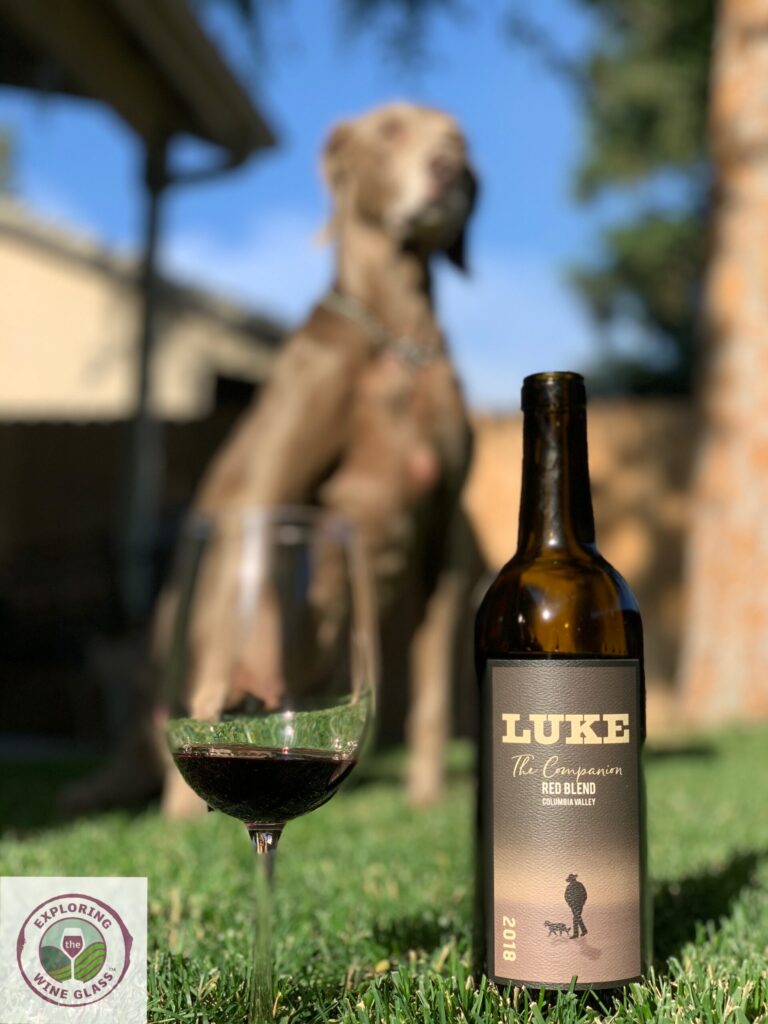You can go to extremes with impossible schemes
You can laugh when your dreams fall apart at the seams
And life gets more exciting with each passing day
And love is either in your heart or on it’s way
yep, if you are young at heart.
This month’s Wine Studio introduced us to George Tita of Tanaro River Imports,who specializes in northern Italian and French wines. The theme was Old-School; Young Winemakers. These wines were received as samples, but the opinions are my own. The wines we tasted were all produced by vintners who may be young on the age scale, but have all decided to follow the tested and tried growing philosophies of their ancestors.
George Tita of Tanaro River Imports,who specializes in northern Italian and French wines. The theme was Old-School; Young Winemakers. These wines were received as samples, but the opinions are my own. The wines we tasted were all produced by vintners who may be young on the age scale, but have all decided to follow the tested and tried growing philosophies of their ancestors.
What is #WineStudio you ask? PROTOCOL Wine Studio are Sommeliers and professionals who are dedicated to the wine trade and all those who support it. Our goal is to explore expanding dimensions of the wine world to evolve concepts in wine sales and education. It is a twitter based program that gets together on Tuesday evenings at 9pm EST to discuss wine and share opinions and knowledge.
Week 1
Week 1 brought us to Alsace, France. As with many of the wines in Alsace these wines have been shaped by the region’s German ancestry. The wines tend to be either white or single varietal and do not see much, if any oak. The wines are named after the grape varietal (like German wines) rather than the region (French wines). With the Vosges Mountain range blocking the Atlantic influence, the vignerons are able to allow the fruit to hang on the vines longer without fear of damaging rain, while the cool nights provide the grapes with the region’s acidic MO.
Florian Beck-Hartweg

Located in Alsace, France this winery’s working philosophy is that the soil does the talking. They believe the vineyard is the most important aspect of the wine making process and they respect the land. Replacing machinery with hard manual labor, they allow the grapes to talk. With their hands involved in every aspect of the wine making process from dirt to bottle, they do the work all themselves. As of 2011, all of their wines are certified organic.

2012 Riesling
This 2012 Riesling poured daffodil in color. Aromas of a freshly peeled nectarine, petrol, and lemon zest while it produced flavors of lemon pith and chalk. It was a sweeter Riesling. George informed us that once the fruit is picked and sorted, it goes through a soft crush in stainless steel. It then undergoes an extremely long and slow fermentation in ancient wood using all natural yeast. They recommend drinking within four years of bottling. There may be some lees within the bottle and natural CO2.
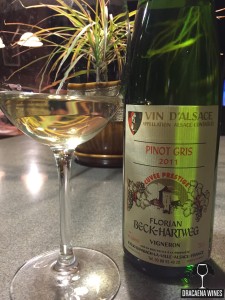
2011 Pinot Gris
This 2011 Cuvée poured blonde in color. Aromas of stone fruit (apricot) with some minerality on the nose while it produced flavors of apricot followed by peach and finishes with forest floor. It had balanced acidity and not overly sweet with a medium body and medium finish. The fruit is grown in a Granitic, sandy and silty soil with an Eastern exposure. Once again, the fruit is 100% manually harvested but unlike the Riesling, the Pinot Gris grapes are placed in a pneumatic press and the wild-yeast fermentation occurs during the 1 to 3 months in old oak casks. Finally, the wine is aged 4 to 6 more months on the lees. Recommended to drink within 4 years following the bottling.
Week 2
For the second week of #winestudio, we traveled south and crossed the border to Italy. We sipped Azienda Agricola Brangero 2012 Dolcetto di Diano D’Alba “San Rabino Soprano” from Piemonte, Italy and Cantina Roagna Giuseppe di Marco 2014 Barbera d’Alba from Roero, Italy.
Piedmont, is one of twenty regions of Italy and is located on the border of France and Switzerland. It is surrounded by the Alps on three sides. Being home to 1/3 of the Italian population, it is the second largest region behind Sicily. It is believed that the exceptional cold of the Alps and the warmth of the Mediterranean create the diurnal climate that is perfect for grapes. Roero is located in the north-east corner of the province of Cuneo in Piedmont.
Azienda Agricola Brangero
Brangero is one of two farms owned by a parent company and is located in Piedmont. This site produces Chardonnay, Arneis, Dolcetto, Nebbiolo, Barbera & Barolo. The farm is located in Diano d’Alba and maintains stunning views of the Langhe hills and the town of Alba. In their words, their wine making philosophy is: [to] understand and interpret the territory, the environment and the vine is the basis for excellent wines, recognizable and with personality. The wine must be expression of the land and the people who work for it.
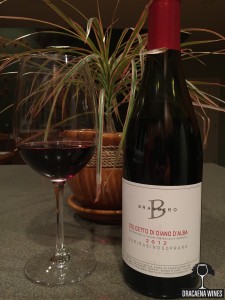
2012 Dolcetto DiDiano D’Alba
This 2012 Dolcetto pours cherry in color. On the nose we were greeted with aromas of sweet cherry, leather and forest floor. Our palate was impressed with the flavors of sweet cherry, tar and a hint of acidity. A bit more ripeness to the fruit would round out the acidity a bit more. This was a medium bodied wine with a light finish. Fermentation and maceration on the skins took place for 15 days at a controlled temperature of 28oC. No oak is used in the aging process.
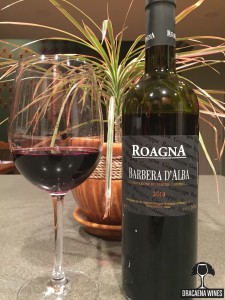
2014 Roagna Barbera D’Alba
This 2014 Barbera poured berry in color. On the nose were aromas of sour cherry and herbs with mild eucalyptus. Our palate was enchanted with cherry, licorice, herbal hints and flint. The wine was extremely balanced with a medium body and medium/plus finish. The fruit is manually harvested and placed gently into small containers. Fermentation, which takes ten days, occurs in large wood casks with all natural yeasts. Afterwards, maceration is performed which lasts for at least two and a half months. The wine is then aged in a neutral oak barrel for approximately five years.
Week 3
This week’s first wine kept us in the Piedmont region of Italy with a Nebbiolo from the Barolo DOCG. The second wine, a Sangiovese blend, had us travel further south to Montefalco DOC in Umbria, which is located in the mid-calf of Italy.
As I researched these wines, I found that Montefalco Rosso wines are required to contain 60-70% Sangiovese, 10-15% Sagrantino and 15-30% other varieties such as Merlot and Cabernet Sauvignon. (Thank you Jon, The Reverse Wine Snob) I also discovered that I was extremely lucky to even get this bottle since it is very difficult to find in the USA since it is mostly consumed in Italy. I found an interesting article on the re-emergence of the Sagrantino grape in this article in the San Jose Mercury News.
Germano Angelo
This winery dates back to 1902 by Theobold Germano. Back then they almost exclusively produced Nebbiolo and received their fair share of awards. In 1903 he received the gold medal in Alba, Cuneo and Turin and in 1905 he was awarded with the cup of His Majesty the King. This was the highest honor that a wine could receive at that time. But over time, the winery dissolved. In 1908, Angelo purchased the vineyards using his wife’s dowry. In 1936, Davide Germano purchased a farm and its vineyards in the village of Bussia of Monforte d’Alba, the “darts “one of the best areas of the entire territory of Barolo. Today it is Davide Germano Jr who runs the winery. His goal is to focus on honesty and relevance of an exceptional wine and protect the winemaking process of his ancestors. He wants to be known as the most authentic soul of the Langhe can not help but enjoy a wine accompanied by classic dishes, here, in the Langhe, in the home of Barolo.
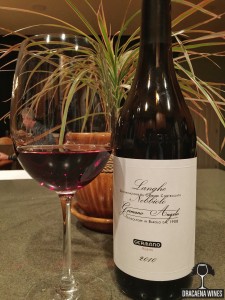
2010 Germano Angelo Azienda 2010 Nebbiolo d’Alba “Visette”
This 2010 Nebbiolo poured light brick in color. It contained aromas of cherry NyQuil, raspberry and licorice. The cherry syrup continued into the flavors followed by some anise and finally dried cranberry. The wine had a light (+) body with a medium finish. The wine was fermented and macerated in stainless steel tanks for ten to twelve days at a temperature of between 83o and 86oF. Crush occurs by hand and MLF is also in stainless steel, however the wine is transferred to large oak casks where it can age for 12 months. Bottling occurs in August, two years after harvest and the wine is not released for an additional twelve months.
Azienda Agricola Romanelli
The winery’s history began in 1978 when a father and son decided live the life of farmers. Today, three generations live and work with passion to ‘internal’ s company which with the passing of years the typical productions d ‘excellence such as oil and wine, inextricably linked with the territory, have acquired an increasingly important role and can become the focal points. They are extremely focused on protecting the environment and believe in living as close to nature as possible. They perform only organic fertilization in both their vineyards and olive groves. They understand their relationship with groundwater and wildlife and work feverishly to correct and balanced crop nutrition. This balance is what they believe provides for the perfect symmetry between vegetation and production.
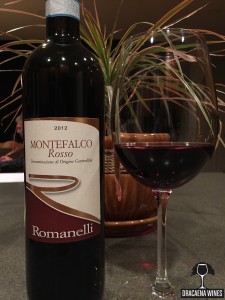
2012 Romanelli Montefalco Rosso
This red blend which consist of 65% Sangiovese, 15% Sagrantino, 10% Merlot, and 10% Cabernet Sauvignon poured cherry in color. On the nose we were greeted with rosemary stem, earthiness and I swear Mike’s homemade tomato soup. Maybe it’s what Mike puts in the soup, but I can’t lie, that’s what memory flashed in my mind when my olfactory system got whiff of it. Earthy and herbaceous stem flavors intrigued us. The wine was medium body and light (+) finish. It had biting tannins which makes sense since according to George, Montefalco Sagrantino has the honor of being the most tannic grape in Italy (maybe the world.) Definitely a food wine.
The grapes are all hand-picked and immediately transported to the winery where they get de-stemmed and see a very gentle pressing. The temperature is controlled throughout fermentation. Maceration occurs on skins for approximately 40 days, afterwards the wine is aged in various sized French oak barrels (225 – 2500L). It is then filtered and bottled. Release occurs about two months after bottling.
I would like to thank both George Tita of Tanaro River Imports and Protocol Wine Studio for allowing me the opportunity to explore these wines. It was an exceptional month of wine and learning. I highly recommend spending your Tuesday evenings with them on twitter. Join in the chat on Tuesdays at 9pm EST by following #Winestudio. They are also on blab from just prior to the tweetup.
~Sláinte!


